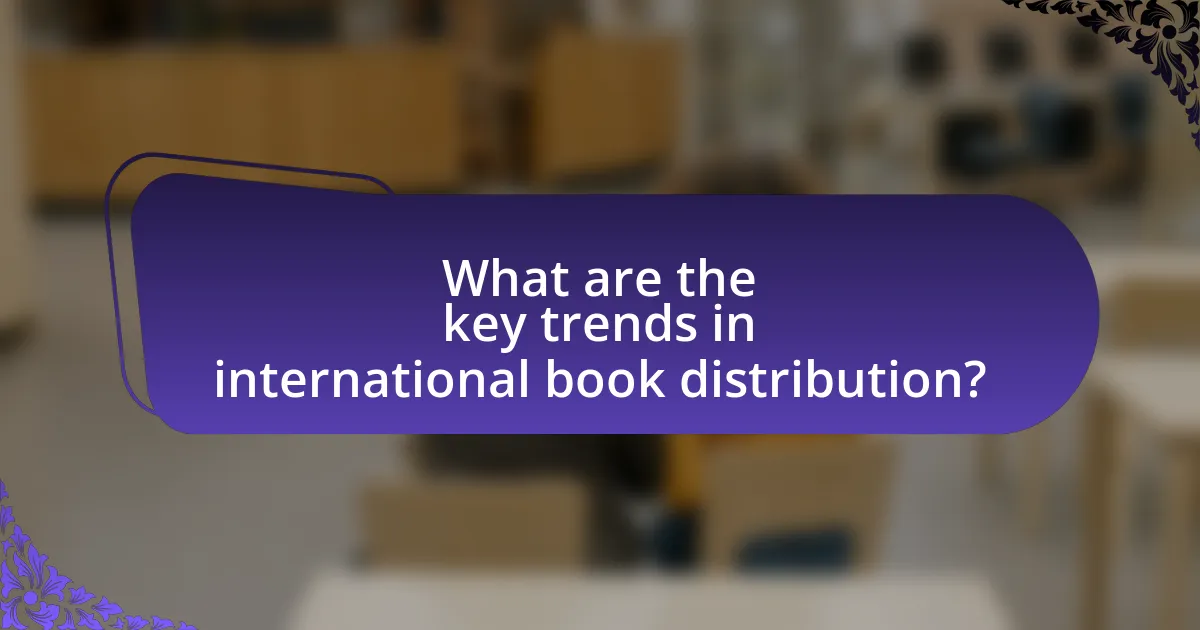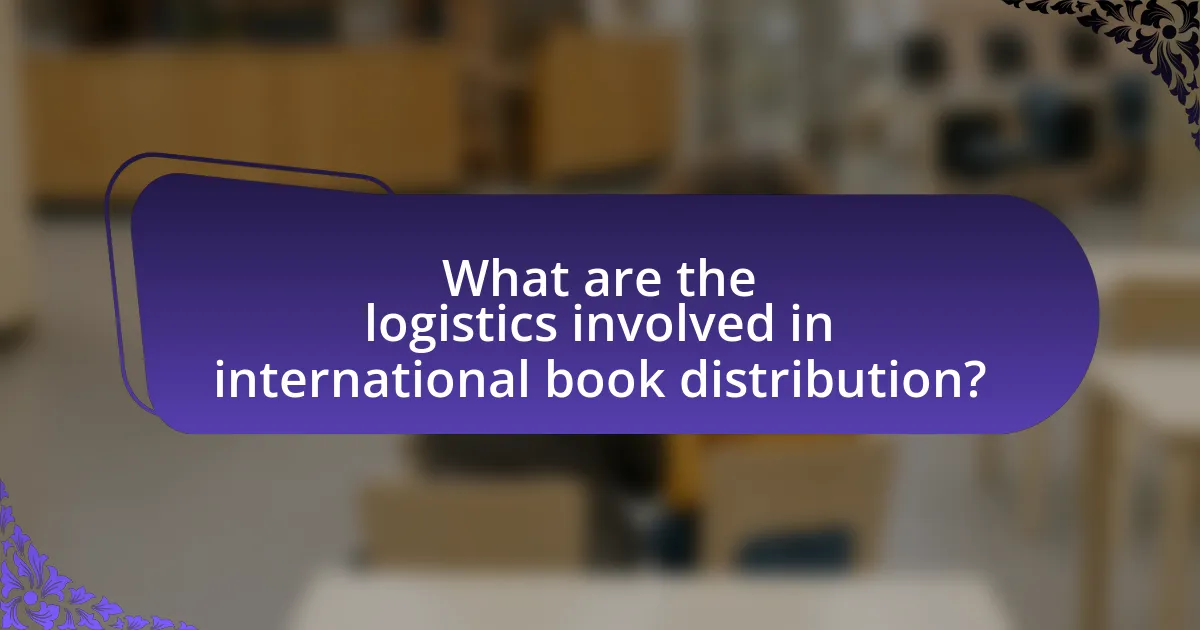The article focuses on the key trends in international book distribution, highlighting the impact of digital platforms, the demand for localized content, and the rise of direct-to-consumer sales. It examines how technology has transformed distribution processes, enabling wider access to global markets through e-books and print-on-demand services. Additionally, the article discusses emerging markets such as India, Brazil, and Nigeria, and the cultural differences that influence distribution strategies. It also addresses the logistics involved in international distribution, regulatory considerations, and best practices for publishers to enhance their success in navigating global markets.

What are the key trends in international book distribution?
Key trends in international book distribution include the rise of digital platforms, increased demand for localized content, and the growth of direct-to-consumer sales. Digital platforms, such as Amazon and other e-commerce sites, have transformed how books are distributed globally, allowing for wider reach and accessibility. The demand for localized content has surged, as publishers recognize the importance of cultural relevance in different markets, leading to tailored marketing strategies and translations. Additionally, direct-to-consumer sales have gained traction, with authors and publishers leveraging social media and online marketing to connect directly with readers, bypassing traditional distribution channels. These trends reflect the evolving landscape of the publishing industry, driven by technology and changing consumer preferences.
How has technology influenced international book distribution?
Technology has significantly influenced international book distribution by streamlining processes and expanding access to global markets. Digital platforms, such as Amazon and Google Books, have enabled publishers to reach a wider audience without the constraints of traditional distribution channels. For instance, the rise of e-books and print-on-demand services has reduced the need for large print runs and inventory storage, allowing for more flexible and cost-effective distribution methods. According to a report by the International Publishers Association, the global e-book market was valued at approximately $18 billion in 2020, highlighting the shift towards digital formats that facilitate international sales. Additionally, advancements in logistics and supply chain management, driven by technology, have improved shipping efficiency and reduced delivery times, further enhancing the accessibility of books across borders.
What role do e-books play in global distribution trends?
E-books significantly enhance global distribution trends by facilitating immediate access to a vast array of titles across diverse markets. Their digital nature allows publishers to bypass traditional distribution barriers, such as shipping costs and physical inventory limitations, enabling instant delivery to consumers worldwide. According to a report by the International Publishers Association, e-book sales accounted for approximately 20% of the global book market in 2021, illustrating their growing importance in international distribution. This shift not only democratizes access to literature but also allows publishers to reach underserved markets, thereby expanding their audience and increasing overall sales.
How are digital platforms changing the landscape of book distribution?
Digital platforms are transforming book distribution by enabling direct access between authors and readers, bypassing traditional intermediaries. This shift allows for a broader reach, as platforms like Amazon and Apple Books facilitate global distribution, making books available to diverse audiences instantly. According to a 2021 report by the Association of American Publishers, eBook sales accounted for 20% of the overall book market, highlighting the significant impact of digital platforms on consumer purchasing behavior. Additionally, self-publishing has surged, with platforms like Kindle Direct Publishing allowing authors to publish and distribute their works without the need for traditional publishing houses, further democratizing the market.
What are the emerging markets for book distribution?
The emerging markets for book distribution include countries such as India, Brazil, and Nigeria. These markets are experiencing rapid growth due to increasing literacy rates, expanding middle-class populations, and rising internet penetration. For instance, India has seen a significant rise in e-book sales, with a projected growth rate of 25% annually, driven by a young, tech-savvy demographic. Brazil’s book market is also expanding, with a focus on digital formats, as the country ranks among the top ten in global book production. In Nigeria, the growth of mobile technology is facilitating access to digital books, contributing to a burgeoning market for both print and electronic publications.
Which countries are experiencing growth in book sales?
Countries experiencing growth in book sales include India, China, and Brazil. In India, the book market has seen a significant increase, with a reported growth rate of around 20% annually, driven by a rising middle class and increased literacy rates. China has also shown robust growth, with the publishing industry expanding by approximately 5% each year, fueled by digital sales and a growing interest in reading among younger generations. Brazil’s book market is recovering post-economic downturn, with a growth rate of about 3% as of recent reports, supported by government initiatives promoting reading and literacy.
What factors contribute to the rise of these emerging markets?
The rise of emerging markets is primarily driven by economic growth, increased foreign investment, and technological advancements. Economic growth in these regions often results from a combination of rising consumer demand, urbanization, and improved infrastructure. For instance, countries like India and Brazil have experienced significant GDP growth rates, with India averaging around 7% annually over the past decade, attracting substantial foreign direct investment (FDI). Increased foreign investment is facilitated by favorable government policies and trade agreements that encourage international businesses to enter these markets. Additionally, technological advancements, particularly in digital platforms, have enabled better access to information and services, further stimulating market growth. For example, the proliferation of mobile technology in Africa has transformed various sectors, including finance and education, contributing to economic development.
How do cultural differences impact book distribution strategies?
Cultural differences significantly impact book distribution strategies by influencing consumer preferences, purchasing behaviors, and marketing approaches. For instance, in collectivist cultures, such as those in East Asia, books that emphasize community and family values tend to perform better, prompting distributors to focus on titles that resonate with these themes. Conversely, in individualistic cultures like the United States, books that highlight personal achievement and self-expression are more popular, leading to different promotional tactics and distribution channels.
Additionally, language barriers and local customs necessitate tailored marketing strategies; for example, localized editions and culturally relevant content can enhance market penetration. Research indicates that understanding cultural nuances can increase sales by up to 30% in foreign markets, as seen in the success of localized editions of popular series like Harry Potter in various countries. Thus, cultural differences dictate not only the types of books distributed but also the methods and channels used to reach diverse audiences effectively.
What are the challenges of distributing books in diverse cultural contexts?
Distributing books in diverse cultural contexts presents challenges such as language barriers, differing cultural norms, and varying legal regulations. Language barriers complicate the translation and localization of content, making it difficult for publishers to ensure that the material resonates with local audiences. Differing cultural norms can affect the acceptance of certain themes or topics, leading to potential censorship or rejection of books in specific markets. Additionally, varying legal regulations regarding copyright, distribution rights, and import/export restrictions can hinder the smooth flow of books across borders. For instance, in some countries, strict censorship laws may limit the types of books that can be published or distributed, impacting the availability of diverse literature.
How can publishers adapt their strategies to different markets?
Publishers can adapt their strategies to different markets by conducting thorough market research to understand local preferences, cultural nuances, and purchasing behaviors. This approach allows publishers to tailor their content, marketing, and distribution methods to align with the specific needs of each market. For instance, a study by the International Publishers Association highlights that localized content significantly increases engagement and sales in diverse regions, demonstrating the effectiveness of adapting strategies based on market insights. Additionally, leveraging partnerships with local distributors can enhance market penetration and facilitate better understanding of regional trends.

What are the logistics involved in international book distribution?
International book distribution logistics involve a series of coordinated processes including inventory management, shipping, customs clearance, and local distribution. These logistics ensure that books are efficiently transported from publishers to retailers or consumers across borders.
Inventory management requires accurate tracking of stock levels and demand forecasting to optimize supply chains. Shipping involves selecting appropriate carriers and routes, often utilizing air or sea freight, depending on cost and delivery speed. Customs clearance is critical, as it involves compliance with international trade regulations and tariffs, which can vary significantly by country. Finally, local distribution entails working with regional distributors or retailers to ensure timely delivery to end customers.
For instance, according to the International Publishers Association, the global book market was valued at approximately $143 billion in 2020, highlighting the importance of effective logistics in reaching diverse markets.
How do publishers manage supply chain logistics for global distribution?
Publishers manage supply chain logistics for global distribution by utilizing a combination of technology, strategic partnerships, and efficient inventory management. They implement advanced software systems for tracking shipments and managing orders, which enhances visibility and coordination across different regions. Additionally, publishers often collaborate with local distributors and logistics providers to navigate regional regulations and optimize delivery routes. For instance, the use of print-on-demand technology allows publishers to reduce inventory costs and respond quickly to market demands, thereby improving their overall supply chain efficiency.
What are the key components of an effective supply chain in book distribution?
The key components of an effective supply chain in book distribution include inventory management, logistics, supplier relationships, demand forecasting, and technology integration. Inventory management ensures that the right amount of books is available to meet customer demand without overstocking, which can lead to increased costs. Logistics involves the efficient transportation and warehousing of books, ensuring timely delivery to retailers and customers. Strong supplier relationships facilitate better negotiation terms and reliability in sourcing books. Demand forecasting uses historical sales data and market trends to predict future sales, allowing for better planning and resource allocation. Finally, technology integration, such as using supply chain management software, enhances visibility and coordination across the supply chain, improving overall efficiency. These components collectively contribute to a streamlined and responsive book distribution process.
How do shipping and handling affect distribution efficiency?
Shipping and handling significantly impact distribution efficiency by influencing delivery speed, cost, and reliability. Efficient shipping methods reduce transit times, which enhances customer satisfaction and retention. For instance, a study by the Council of Supply Chain Management Professionals found that companies optimizing their shipping processes can reduce delivery times by up to 30%, leading to improved service levels. Additionally, effective handling practices minimize product damage and loss, further streamlining the distribution process. According to the Warehousing Education and Research Council, proper handling can decrease return rates by 20%, thereby increasing overall distribution efficiency.
What role do distributors and wholesalers play in the process?
Distributors and wholesalers serve as critical intermediaries in the international book distribution process by facilitating the movement of books from publishers to retailers and ultimately to consumers. They manage inventory, reduce the logistical burden on publishers, and provide access to a broader market by connecting publishers with various retail outlets across different regions. For instance, distributors often handle the complexities of shipping, customs, and local market regulations, which allows publishers to focus on content creation rather than distribution logistics. This role is essential in ensuring that books reach diverse markets efficiently, as evidenced by the fact that over 70% of books sold in international markets are distributed through wholesalers and distributors, highlighting their importance in the global book supply chain.
How do distributors select titles for international markets?
Distributors select titles for international markets by analyzing market demand, cultural relevance, and sales potential. They conduct thorough market research to understand consumer preferences and trends in specific regions, which informs their selection process. For instance, distributors may utilize data from previous sales, demographic studies, and local literary trends to identify titles that resonate with target audiences. Additionally, they consider factors such as the author’s reputation, genre popularity, and existing competition in the market. This strategic approach ensures that the selected titles align with both consumer interests and market viability, ultimately enhancing the likelihood of successful sales in international markets.
What partnerships are essential for successful distribution?
Essential partnerships for successful distribution in international book distribution include collaborations with local distributors, retailers, and logistics providers. Local distributors possess market knowledge and established networks that facilitate access to regional markets, while retailers enhance visibility and sales through their storefronts. Logistics providers ensure efficient transportation and delivery, critical for maintaining supply chain integrity. According to a study by the International Publishers Association, effective partnerships can increase market penetration by up to 30%, demonstrating their importance in optimizing distribution strategies.
What are the regulatory considerations in international book distribution?
Regulatory considerations in international book distribution include compliance with copyright laws, import/export regulations, and taxation policies. Copyright laws vary by country, affecting how books can be reproduced and distributed; for instance, the Berne Convention mandates that member countries recognize the copyright of works from other member states. Import/export regulations may impose restrictions on certain content, requiring adherence to local censorship laws. Additionally, taxation policies, such as Value Added Tax (VAT) or sales tax, can differ significantly across jurisdictions, impacting pricing and profitability. These factors necessitate thorough research and legal consultation to ensure compliance and mitigate risks in international book distribution.
How do copyright laws affect global distribution strategies?
Copyright laws significantly influence global distribution strategies by determining how and where content can be legally shared and sold across different jurisdictions. These laws establish the rights of creators and publishers, which directly impacts decisions regarding licensing, pricing, and market entry strategies. For instance, the Berne Convention mandates that member countries recognize the copyright of works from other member states, thereby facilitating international distribution but also requiring compliance with varying local laws. This complexity necessitates that publishers conduct thorough legal assessments to navigate potential infringements and ensure that their distribution strategies align with copyright regulations in each target market.
What are the import/export regulations that publishers must navigate?
Publishers must navigate various import/export regulations that include compliance with customs laws, intellectual property rights, and trade agreements. These regulations dictate the legal requirements for shipping books across borders, including tariffs, import duties, and documentation such as invoices and certificates of origin. For instance, the World Trade Organization’s Trade Facilitation Agreement aims to simplify customs procedures, which can significantly impact how publishers manage international distribution. Additionally, publishers must ensure adherence to copyright laws in different jurisdictions to avoid legal disputes, as copyright protection varies by country.

What best practices can enhance success in international book distribution?
To enhance success in international book distribution, publishers should prioritize understanding local markets, establishing strong partnerships, and leveraging digital platforms. Understanding local markets involves researching cultural preferences, language nuances, and regional trends, which can significantly influence sales. Establishing strong partnerships with local distributors and retailers ensures better market penetration and access to established customer bases. Leveraging digital platforms, such as e-commerce and social media, allows for broader reach and targeted marketing strategies, which are essential in today’s globalized environment. These practices are supported by data indicating that localized marketing strategies can increase sales by up to 30% in specific regions, demonstrating the effectiveness of tailored approaches in international distribution.
How can publishers effectively market their books in foreign markets?
Publishers can effectively market their books in foreign markets by conducting thorough market research to understand local preferences and cultural nuances. This approach allows publishers to tailor their marketing strategies, including localized content, pricing, and promotional tactics, to resonate with the target audience. For instance, a study by the International Publishers Association highlights that understanding regional reading habits and preferences can significantly enhance a book’s reception in foreign markets. Additionally, leveraging partnerships with local distributors and utilizing social media platforms popular in those regions can further amplify reach and engagement.
What strategies can be employed to reach international audiences?
To reach international audiences, publishers can employ strategies such as localization, digital marketing, and partnerships with local distributors. Localization involves adapting content to meet cultural, linguistic, and regional preferences, which enhances relevance and engagement. For instance, a study by the Localization Industry Standards Association indicates that 75% of consumers prefer to buy products in their native language, highlighting the importance of language adaptation. Digital marketing strategies, including targeted social media campaigns and search engine optimization, can effectively reach diverse demographics across different countries. Additionally, forming partnerships with local distributors can facilitate access to established networks and insights into regional market trends, thereby increasing visibility and sales potential.
How important is localization in marketing efforts?
Localization is crucial in marketing efforts as it directly influences consumer engagement and brand perception in diverse markets. Effective localization tailors marketing messages, product offerings, and customer experiences to resonate with local cultures, languages, and preferences. For instance, a study by Common Sense Advisory found that 72.4% of consumers are more likely to purchase a product if the information is available in their native language, highlighting the significant impact of language on buying decisions. Additionally, brands that localize their marketing strategies can achieve higher customer loyalty and satisfaction, as they demonstrate an understanding of local customs and values.
What are the common pitfalls to avoid in international distribution?
Common pitfalls to avoid in international distribution include failing to understand local regulations, neglecting cultural differences, and underestimating logistics complexities. Understanding local regulations is crucial, as non-compliance can lead to legal issues and financial penalties. For instance, different countries have varying import/export laws that must be adhered to. Neglecting cultural differences can result in marketing missteps, as what appeals to one market may not resonate with another; for example, book covers and titles may need to be adapted for local tastes. Underestimating logistics complexities can lead to delays and increased costs; according to a study by the International Journal of Logistics Management, 30% of international shipments face delays due to inadequate planning. Addressing these pitfalls is essential for successful international distribution.
What mistakes do publishers often make when entering new markets?
Publishers often make the mistake of failing to conduct thorough market research when entering new markets. This oversight can lead to misjudging local consumer preferences, cultural nuances, and competitive landscapes. For instance, a study by the International Publishers Association highlights that understanding regional reading habits and language variations is crucial for success. Additionally, publishers frequently underestimate the importance of establishing local partnerships, which can provide valuable insights and distribution channels. Without these partnerships, publishers risk facing logistical challenges and ineffective marketing strategies that do not resonate with the target audience.
How can these pitfalls be mitigated through planning?
Pitfalls in international book distribution can be mitigated through comprehensive planning by conducting thorough market research, establishing clear logistics strategies, and ensuring compliance with local regulations. Market research identifies potential challenges such as cultural differences and consumer preferences, allowing publishers to tailor their offerings effectively. A well-defined logistics strategy addresses issues related to shipping, warehousing, and distribution channels, which are critical for timely delivery and cost management. Compliance with local regulations, including copyright laws and import/export restrictions, prevents legal complications that could disrupt distribution. For instance, a study by the International Publishers Association highlights that companies that invest in detailed market analysis and logistics planning experience a 30% reduction in operational disruptions.
What practical tips can help publishers navigate global markets?
Publishers can effectively navigate global markets by conducting thorough market research to understand local preferences and trends. This involves analyzing data on consumer behavior, regional bestsellers, and cultural nuances that influence reading habits. For instance, a report by the International Publishers Association highlights that understanding local languages and customs significantly enhances market entry success. Additionally, establishing partnerships with local distributors can facilitate access to established networks and streamline logistics, as evidenced by successful collaborations in various regions that have led to increased sales and brand recognition. Finally, leveraging digital platforms for marketing and distribution can expand reach and reduce costs, as seen in the rise of e-books and online sales channels globally.



